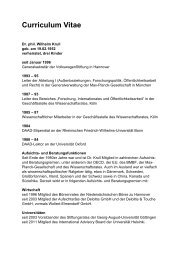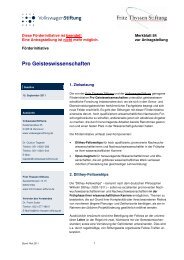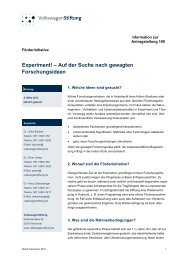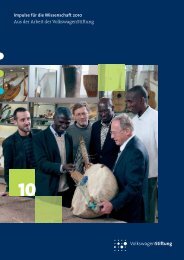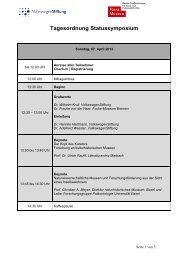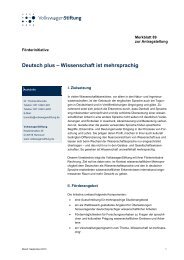Funding
Funding
Funding
Create successful ePaper yourself
Turn your PDF publications into a flip-book with our unique Google optimized e-Paper software.
8<br />
Organization<br />
The Foundation is governed by the Board of<br />
Trustees. It comprises 14 eminent persons drawn<br />
from the domains of academia, politics, and industry<br />
(see page 94), of whom seven are appointed by<br />
the Federal Government and seven by the State of<br />
Lower Saxony. Their period of office is five years<br />
and they can be reappointed for one further term.<br />
The Trustees are completely independent and<br />
responsible only to the Foundation’s statutes.<br />
The Board usually convenes about three times a<br />
year to discuss and formulate strategy and to decide<br />
on applications. The Trustees are responsible for<br />
the annual budget and the annual accounts, as<br />
well as the publication of the Foundation’s annual<br />
report and appointment of the Secretary General.<br />
Dr. Wilhelm Krull has been Secretary General of<br />
the Foundation since 1996, and is as such responsible<br />
for its management.<br />
Currently the Volkswagen Foundation’s office has<br />
a staff of about 90, mainly spread over three divisions:<br />
There is one division dealing with research<br />
funding, the other divisions care for finance and ad -<br />
ministration and manage the Foundation’s assets.<br />
The office staff prepare the proposals for the<br />
Board of Trustees and execute the Board’s decisions.<br />
This involves the conceptualization and<br />
implementation of funding initiatives, processing<br />
applications, informing and advising the applicants,<br />
and monitoring the funded projects from<br />
start to finish. In addition, the grants have to be<br />
administered and checked to see that they have<br />
been used correctly and efficiently for the immediate<br />
purpose for which they were allocated.<br />
An interdisciplinary training program gives young academics<br />
from Central Asia the opportunity to hone their research skills.<br />
Participants of the LUCA program gathered in front of the main<br />
entrance to Gießen University: (from the left) Kenjabaev Shavkat<br />
(Uzbekistan), Murataly Duishonakunov (Kyrgyzstan), Daniela<br />
Chase (Gießen University), Boris Gojenko (Uzbekistan), Parviz<br />
Khakimov (Tajikistan), Natalya Tsychuyeva (Kazakhstan), Kanayim<br />
Teshebaeva (Kyrgyzstan), Shahzod Avazov (Tajikistan), Ilhkomjon<br />
Aslanov (Uzbekistan), Saltanat Sabitova (Kazakhstan).<br />
Finance and Administration<br />
Administering the Foundation’s finances and<br />
budgeting is a task for professional management.<br />
This is provided by the Finance and Administration<br />
Division, which takes care of the Foundation’s<br />
accounting and financial controlling. In accordance<br />
with requirements laid down in the Foundation’s<br />
statutes, this group also prepares the annual finan -<br />
cial statements for the Foundation’s auditors and<br />
ensures the internal control of assets.<br />
The unit Human Resources and Central Services<br />
is involved in the planning and implementation<br />
of everything necessary to efficient staffing. It<br />
also maintains the infrastructure necessary to<br />
ensure the smooth running of the office.<br />
The coordination and development of the Foun -<br />
dation’s IT requirements is managed by the group<br />
Information and Communication Systems.<br />
Investment Management<br />
The Investment Management Division takes care<br />
of the Foundation’s capital assets, currently €2.3<br />
billion. Their task pursues two main objectives:<br />
One is to ensure the sustained funding of research<br />
projects, the other is to maintain the real value of<br />
the Foundation’s capital in the face of inflationary<br />
pressure. This calls for investment not only in<br />
interest-bearing securities, but also in stocks and<br />
real estate. The investment strategy in these three<br />
main areas is based on the portfolio theory of risk<br />
diversification: the greater the spread and trade<br />
off between risks and opportunities, the greater<br />
the yield.






